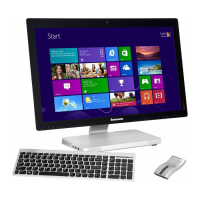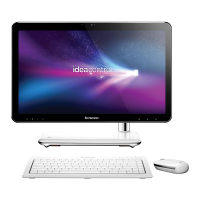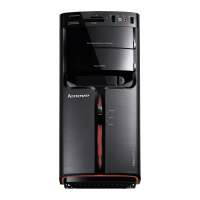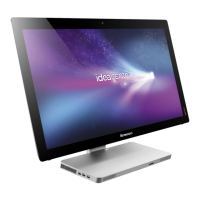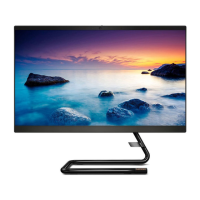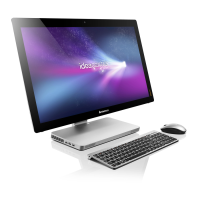
Do you have a question about the Lenovo IdeaCentre A720 and is the answer not in the manual?
| Bus type | DMI |
|---|---|
| Tjunction | 105 C °C |
| Processor cache | 6 MB |
| Processor cores | 4 |
| Processor model | i7-3610QM |
| System bus rate | 5 GT/s |
| 64-bit computing | Yes |
| Processor family | Intel® Core™ i7 |
| Processor series | Intel Core i7-3600 Mobile series |
| Processor socket | Socket G2 |
| Processor threads | 8 |
| Processor codename | Ivy Bridge |
| Processor frequency | 2.3 GHz |
| Processor cache type | Smart Cache |
| Processor lithography | 22 nm |
| Processor manufacturer | Intel |
| Processor front side bus | - MHz |
| PCI Express slots version | 3.0 |
| Processor boost frequency | 3.3 GHz |
| Processor operating modes | 64-bit |
| ECC supported by processor | No |
| PCI Express configurations | 1x16, 2x8 |
| Thermal Design Power (TDP) | 45 W |
| CPU multiplier (bus/core ratio) | 23 |
| Maximum number of PCI Express lanes | 16 |
| Memory types supported by processor | DDR3/L/-RS 1333/1600 |
| Memory channels supported by processor | Dual |
| Memory clock speeds supported by processor | 1333, 1600 MHz |
| Memory bandwidth supported by processor (max) | 25.6 GB/s |
| Maximum internal memory supported by processor | 32 GB |
| Memory slots | 2 |
| Internal memory | 8 GB |
| Memory slots type | SO-DIMM |
| Memory clock speed | 1600 MHz |
| Internal memory type | DDR3-SDRAM |
| Memory layout (slots x size) | 2 x 4 GB |
| HDD speed | 5400 RPM |
| HDD interface | SATA III |
| Storage media | HDD |
| Optical drive type | Blu-Ray ROM |
| Total storage capacity | 1000 GB |
| Compatible memory cards | Memory Stick (MS), miniSDHC, MS PRO, SD, SDXC |
| Number of storage drives installed | 1 |
| Graphics card family | Intel, NVIDIA |
| Storage drive interface | Serial ATA III |
| Compliance industry standards | IEEE 802.3, IEEE 802.3u, IEEE 802.3ab |
| Display diagonal | 27 \ |
| Touch technology | Multi-touch |
| Native aspect ratio | 16:9 |
| On-board graphics card ID | 0x166 |
| Discrete graphics card model | NVIDIA® GeForce® GT 630M |
| On-board graphics card model | Intel® HD Graphics 4000 |
| Discrete graphics card memory | 2048 GB |
| On-board graphics card family | Intel® HD Graphics |
| On-board graphics card base frequency | 650 MHz |
| On-board graphics card dynamic frequency (max) | 1100 MHz |
| Number of displays supported (on-board graphics) | 3 |
| Total megapixels | - MP |
| Wi-Fi standards | 802.11b, 802.11g, Wi-Fi 4 (802.11n) |
| Ethernet LAN data rates | 10, 100, 1000 Mbit/s |
| USB 2.0 ports quantity | USB 2.0 ports have a data transmission speed of 480 Mbps, and are backwards compatible with USB 1.1 ports. You can connect all kinds of peripheral devices to them. |
| VGA (D-Sub) ports quantity | - |
| Product color | Silver |
| Operating system installed | Windows 7 Home Premium |
| Processor ARK ID | 64899 |
| Processor package size | 37.5 x 37.5 (rPGA988B) mm |
| Supported instruction sets | AVX |
| Intel Identity Protection Technology version | 1.00 |
| Depth (with stand) | 200 mm |
|---|---|
| Width (with stand) | 650 mm |
| Height (with stand) | 480 mm |
| Weight (with stand) | 11600 g |
Details the front of the computer, identifying built-in microphone, camera, speakers, indicators, and buttons. Includes air vent warning.
Illustrates left and right views, showing ports like USB, HDMI, optical drive, and card reader. Includes a warning about disc size.
Provides instructions and visuals for installing a B-CAS card, specifically for Japan market models.
Shows the rear of the computer, detailing connections for TV tuner, audio, USB, power, Ethernet, and security slot.
Explains how to position the display using the stand and provides a warning for horizontal use.
Guides on connecting microphones, headphones, USB devices, Ethernet, HDMI, and TV-Tuners.
Explains how to turn on the computer using the power button and notes touch functionality of screen buttons.
Provides step-by-step instructions for calibrating the touch screen for accurate input response in Windows 7.
Explains various touch screen gestures including clicks, dragging, sliding, zooming, and rotation for user interaction.
Lists essential precautions for touch screen use, covering physical care, cleanliness, and environmental factors.
Details using OneKey Recovery to restore the computer to factory default settings or a previous backup state.
Guides on reinstalling Lenovo drivers and applications via automatic or manual methods within the rescue system.
Explains configuration of network settings and management of passwords for the Lenovo Rescue System.
Provides instructions for backing up the system partition to an image file for future restoration.
Explains how to restore the computer system from backup points or initial factory default settings.
Guides on creating bootable recovery discs from the current system for restoration processes.
Addresses display problems like blank screens, property settings, and screen ripples with troubleshooting steps.
Offers solutions for inaccurate touch screen response by guiding users through the calibration process.
Provides troubleshooting for no sound from speakers or headphones, covering volume, drivers, and connections.
Explains exiting unresponsive programs via Task Manager and resolving program installation/uninstallation problems.
Covers troubleshooting for optical drives not reading discs and explains hard disk capacity indicators.
Offers specific advice for troubleshooting Windows, including serial numbers, driver support, and media center use.
Details daily cleaning procedures for computer components like the monitor and keyboard to prevent dust.

